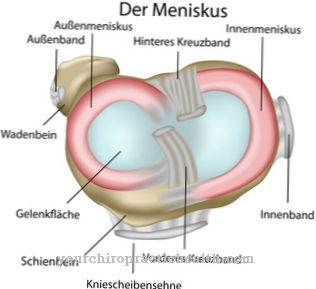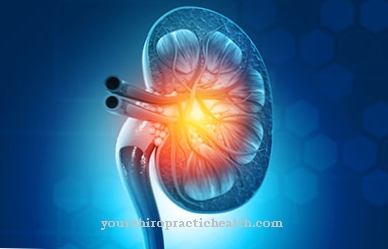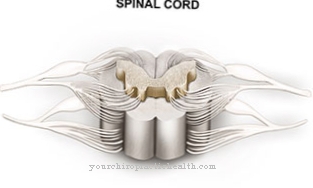frailty or. Old age is the age-related exhaustion and decreased performance that can be considered natural. The frailty is pathological when it becomes the so-called Frailty Syndrome increases. This is characterized by an increased susceptibility to infections compared to peers, accompanying illnesses and rapidly increasing weakness. Frailty syndrome is incurable, but its progression can be stopped.
What is frailty

© majonit - stock.adobe.com
Frailty is not an independent disease, it is a complex phenomenon of old age. The aging process leads to memory, organ and functional disorders that require medical and nursing support. Frailty is considered a normal, natural symptom of old age, for which there is initially no need for therapy.
Only the so-called Frailty Syndrome, which is associated with increased physical and mental weakness compared to the age group and symptoms such as exhaustion, weight loss and unsteady gait, requires treatment. The consequences of frailty are muscle breakdown and weakness, osteoporosis and an increased risk of fractures.
causes
The primary cause is the age of the person affected. After a certain age, old age and frailty tend to seem unstoppable and natural. For this reason, medical research only deals with frailty syndrome, as only this is considered medically relevant and in need of treatment.
Frailty syndrome appears to be based on various risk factors and developmental processes, including diseases such as diabetes mellitus and hypertension, chronic inflammatory processes in the body, and sociodemographic and psychological factors. Those affected showed an increase in the likelihood of inflammation in the body, a weaker immune system than is usual in the age group, anemia and a changed hormone level.
An elevated CRP level seems to be typical of Frailty Syndrome. A reduced testosterone level could also be determined and, in combination with a too low vitamin D level, leads to muscle weakness.
An age-dependent prevalence of Frailty Syndrome could be determined, so this increases significantly from 65 years.
Symptoms, ailments & signs
A frailty is usually expressed by a decrease in physical performance. Affected people are quickly exhausted and consequently less active. The movements are slowed down and the ability to react is usually also greatly reduced. In general, physical activity is also restricted, which makes symptoms worse.
The lack of exercise leads to a reduction in muscle mass and thus muscle weakness. The gait is usually slow and unsafe. In some patients, muscle loss is accompanied by bone loss. Osteoporosis manifests itself through bone pain, frequent fractures, and other typical symptoms.
Another sign of frailty is sudden weight loss that is difficult for those affected to control. The physical weakness also affects the mental state and often causes emotional exhaustion. The frailty usually occurs at an advanced age.
Hormonal disorders or a genetic predisposition can mean that the symptoms appear at a young age and increase in intensity over time.A characteristic of frailty is that the symptoms increase with age and cannot be permanently alleviated.
Diagnosis & course
If people from a certain age suffer from a noticeably severe old age weakness that is more pronounced than in comparison persons, a doctor should be consulted.
If there is also a suspicion of the presence of frailty syndrome, the doctor will examine the senior citizen more closely. The Fried classification is established for this: If three or more of the following five symptoms occur, the Frailty Syndrome is considered to be certain:
A severe, uncontrolled weight loss of more than 10% in twelve months, Objectively identifiable muscle weakness with loss of strength (this can be measured with strength tests), subjectively perceived mental, physical and / or emotional exhaustion, unsteadiness to walk and stand with an increased risk of falling, immobility and physical instability, which is often associated with slowed reactions, as well as reduced physical performance and activity.
If only one or two symptoms can be diagnosed, but age-related worsening is expected, prefrailty syndrome is diagnosed.
Frailty syndrome must be distinguished from other age-related diseases such as dementia or Alzheimer's. These can occur in addition, but their therapy differs significantly from that of frailty and frailty syndrome.
So far, there are no meaningful studies on the course of the Frailty Syndrome. Scientists, however, draw a comparison with age-related frailty and assume that the burden of disease increases with age. Age-related frailty and frailty syndrome are incurable, but the course can be halted with adequate treatment methods.
Complications
Fragility in old age or after illness is usually associated with various complications. The more frailty that occurs in old age, the greater the risk of accidents. Those affected are less mobile than they were before and suffer from unsteadiness to walk and stand, which can lead to falls and serious injuries.
A typical complication of frailty are femoral neck and inguinal hernias. Older people who already suffer from joint or bone diseases are particularly affected. However, frailty can also arise as a result of another illness and cause serious complications. In connection with type 2 diabetes, high blood pressure and inflammatory processes, there is often an irreversible deterioration of bones, muscles or nerve cords.
As a result, further physical complaints develop, which can exacerbate the original frailty. The limited performance can also be associated with emotional stress. With increasing frailty, those affected often develop depression and anxiety, which must be treated immediately. If a frailty remains untreated in old age, it can lead to a severe course with falls and the development of further physical and mental complaints.
When should you go to the doctor?
The frailty is part of the natural aging process in humans, and normally no doctor needs to be consulted. If it occurs in old age, it is considered to be of little concern and more likely to require a change in lifestyle. An adaptation of the physical possibilities to the lifestyle can be done independently.
Daily tasks have to be completed more slowly because the body no longer has the strength and performance it is used to. Therefore, from a medical point of view, there is often no further need for action. If young people or middle-aged adults suffer from frailty, they should consult a doctor.
There are diseases that need to be examined and treated, as this is by no means a natural phenomenon. If there is additional pain or if there are severe impairments in coping with everyday life, a doctor's visit is advisable.
As soon as there is no longer an independent lifestyle, help is needed. The frailty is a creeping process that develops over years. A doctor is required as soon as the person concerned suffers from the developmental condition or the impairments lead to mental problems. If symptoms such as suicidal thoughts, an insufficient supply of the organism or inadequate hygienic measures occur, a doctor should be consulted.
Doctors & therapists in your area
Treatment & Therapy
A balanced diet is important for the treatment of age-related frailty, especially as a supply of all the necessary nutrients and sufficient fluid intake.
If those affected are too weak or forgetful to eat enough, relatives or carers are asked. In extreme cases, intravenous feeding is possible.
The development of muscles and thus physical strength is also advisable. This takes place either with independent fitness training or with, if necessary, supervised senior sports and physiotherapy.
A combination of strength training and coordination exercises trains the muscles and the brain and reduces the risk of falling.
Outlook & forecast
Regarding frailty itself, it can be said that the prognosis will increase with age. Accordingly, the objective and subjective weakness of the person concerned worsen. Further illnesses, falls and the like accelerate this.
Conversely, frailty worsens the prognosis for those affected in many situations. The risk of complications for operations and hospital stays increases with increasing frailty. Recovery processes also become slower. Broken bones are more likely due to a higher susceptibility to walking errors and falls.
In frail people, it is generally to be expected that diseases will take a more severe course. The consequences of illnesses in combination with frailty syndrome also lead to restricted mobility more often. Those affected are more dependent on support in everyday life and lose their autonomy more quickly.
Frailty can also worsen the prognosis for cognitive abilities. Affected people are also more susceptible to states of confusion. Emotional stress is sometimes less well tolerated and this can lead to more depressive moods or stress reactions.
Overall, frailty can significantly reduce the quality of life and life expectancy of those affected. The prognosis for frailty can be improved if measures are taken to maintain physical functions. If the general state of health of the person concerned improves, he can partially regain his strength.
prevention
The most important preventive measure is the lifelong avoidance of risk factors through a balanced diet and sufficient exercise. Social contact with young people also keeps seniors mentally and physically fit.
Aftercare
Frailty can arise due to various factors. What is meant by this is currently being redefined. Muscular weakness, an increased risk of falls and the inability to cope on your own are part of it. One of the most common reasons for increasing frailty is old age.
This is only about aftercare if the frailty has led to a fall or serious illness. Rather, it is about care and prevention, for example fall prophylaxis. The elderly should use a walking stick or rollator to walk more safely.
Frailty can also occur due to serious illness or as a result of chemotherapy. While medical treatment usually focuses on the clinical picture, aftercare can include psychosocial support, physiotherapy or rehabilitation. After a severe stroke, there is usually a higher degree of need for care. Many aftercare measures are necessary here - from purchasing a care bed to walking training.
The aim of all aftercare measures is to reverse the frailty as much as possible. The patient should be enabled to regenerate gradually. Follow-up care for vitreous bone disease can be even more complex. The frail patient will mostly have to rely on a wheelchair. He may need a high level of care. Many frail people are dependent on the help of home care services.
You can do that yourself
An increase in frailty in old age is completely normal, but countermeasures are indicated at the latest when the disorder takes on pathological proportions or even reaches the stage of so-called frailty syndrome.
One of the most important self-help measures is to lead a healthy lifestyle. In old age people often suffer from anorexia, which can very quickly lead to considerable weight loss combined with an acute nutritional deficiency. Seniors who no longer enjoy eating should therefore have a nutritionist put together a nutrition plan that consists of mostly small but substantial meals.
It is also often easier for seniors to take in calories and nutrients in liquid form. If you still live in your own household, you should buy a blender and process fruit or vegetables into fresh smoothies. This is associated with far less work than cooking and can also be done by people whose physical performance is already severely limited.
The tasty and healthy vegetable puree provides the body with fluids at the same time, which is important because seniors often drink too little. An acute nutrient deficit can also be counteracted by taking nutritional supplements.
It is also important to stimulate the circulation and muscles through regular exercise. In addition to physiotherapy, senior gymnastics, senior swimming or regular walking can also be considered. Mental stimulation should also not be neglected. Even simple measures such as reading the daily newspaper regularly and completing the crossword puzzle have a positive effect.













.jpg)

.jpg)
.jpg)











.jpg)